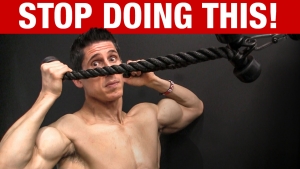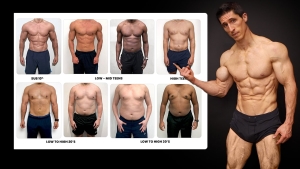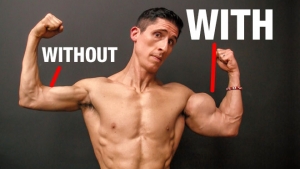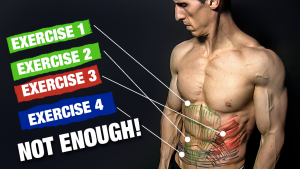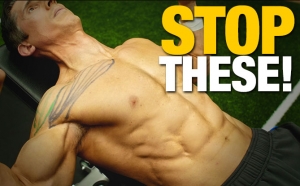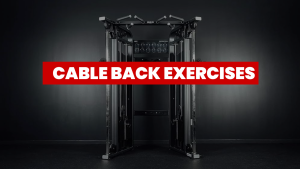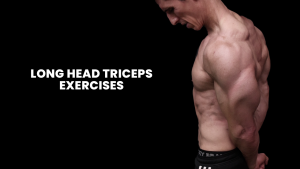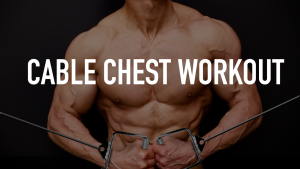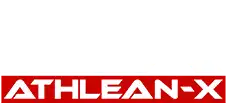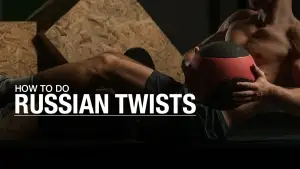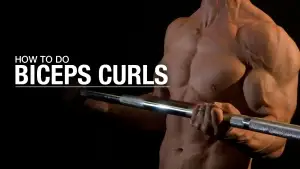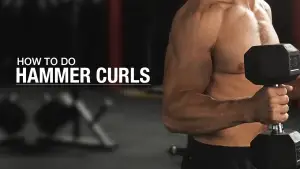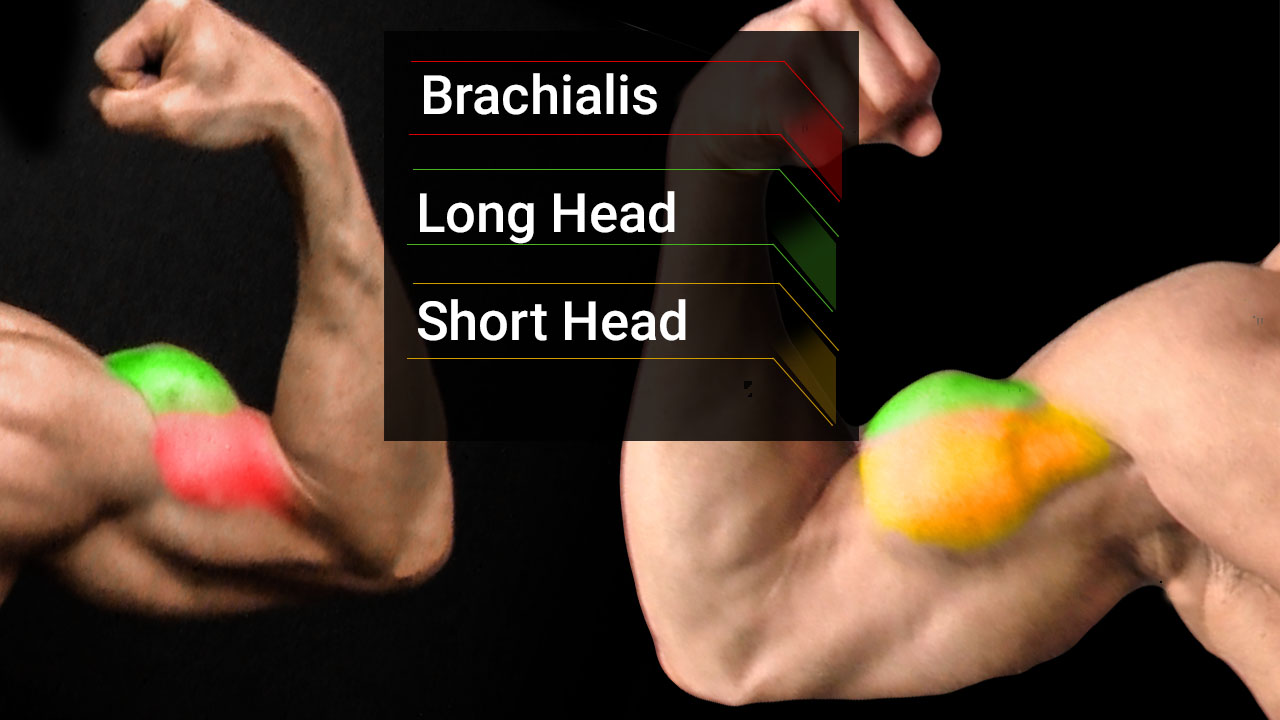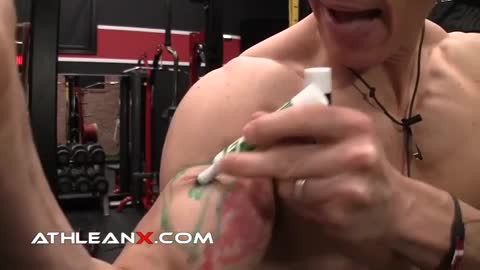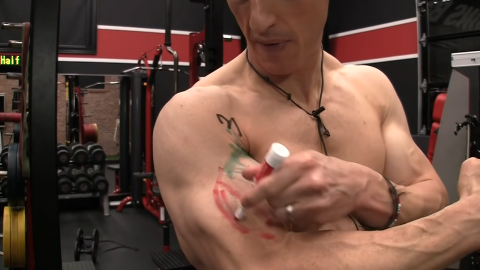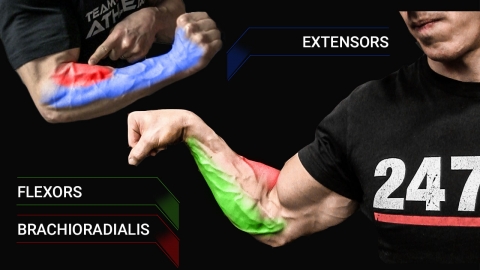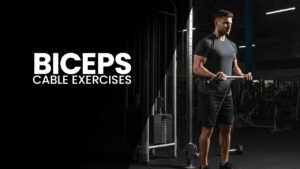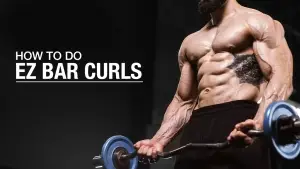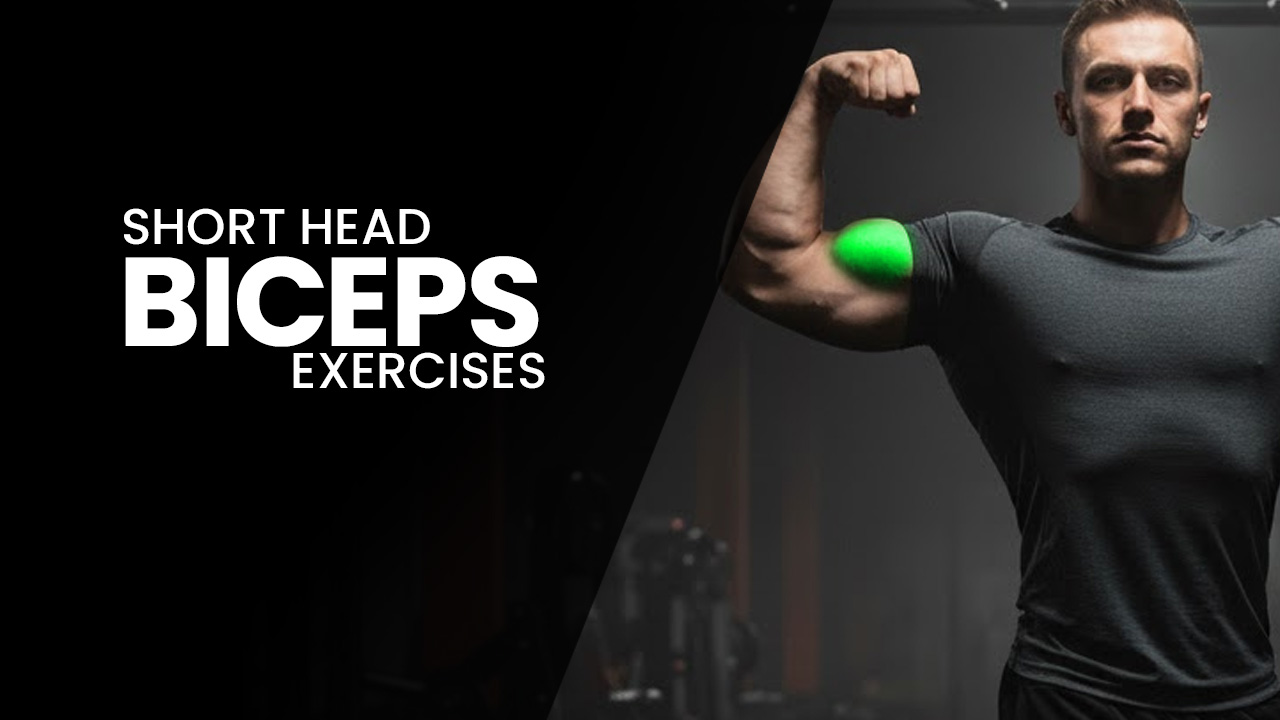
WHY train your biceps short head?
A lot of bicep workouts obsess over the long head of the biceps while completely ignoring the short head.
Why does that matter?
The long head is the outer portion that helps create that high, narrow peak. On the other hand, the short head is the inner section that gives your upper arm its width, density, and front-view size.
If you want arms that look big in a T-shirt, you need to shift your focus.
Today, I’m breaking down exactly what you need to know about the best short head bicep exercises.
We’ll cover the muscles worked, the short head biceps exercises that deliver real results, the most common mistakes destroying your progress, and how to program your training load, training volume, and rest periods for maximum muscle hypertrophy.
SHORT HEAD BICEP EXERCISES: MUSCLES WORKED
Before diving into the exercises, it’s important to understand why certain movements hit harder than others.
Every effective bicep workout relies on precise control over elbow movement, shoulder flexion, and wrist supination.
These factors determine how much the short head or long head of the biceps contributes during each rep. And, more importantly, how your biceps will develop.
Let’s break down the key muscles that drive the performance and muscle-building potential behind your short head bicep exercises.
BICEPS BRACHII: SHORT HEAD
The short head of the biceps sits on the inner side of your upper arm, running from the front of your shoulder down to your forearm.
It lies beside the long head and becomes most visible when you view the arm from the front giving that thick, rounded appearance most lifters chase.
The short head’s primary roles include elbow flexion, shoulder flexion, and wrist supination.
In other words, it’s responsible for bending the arm, lifting the upper arm slightly forward during curls, and rotating the palm upward, which is a critical (and often overlooked) part of full biceps activation.
Movements with a supinated grip and the elbows positioned in front of the body shift the load toward the short head.
This includes Preacher Curls, Concentration Curls, EZ Bar Curls, and Spider Curls. All of which are staples in effective short-head biceps exercises.
On the cable machine, versions like the High Cable Bicep Curl or Drag Curl also keep consistent tension across the strength curve, optimizing muscle activation and muscle hypertrophy.
BICEPS BRACHII: LONG HEAD
The long head of the biceps runs along the outer portion of the upper arm, attaching higher on the scapula.
It contributes to that narrow, tall “peak” that becomes visible when you flex the bicep sideways.
The long head assists with elbow flexion and forearm supination but also plays a stabilizing role during shoulder flexion.
It stretches more during movements that keep the elbows behind the torso, creating a strong muscle elongation effect that’s key for overall muscle growth.
Exercises like Incline Dumbbell Curls, Barbell Curls, and Weighted Chin Ups target the long head by placing the biceps under a deep stretch.
Training on an incline bench or performing Bodyweight Curls on a Pull-Up bar creates a longer resistance profile that challenges the muscle.
However, relying solely on these movements can leave your arms lacking inner fullness. Balancing training volume between the long and short head is important for optimal gains and aesthetic proportion.
BRACHIALIS
Lying underneath the biceps brachii, the brachialis is a thick muscle that connects the humerus (upper arm bone) to the ulna (one of the forearm bones).
Though it’s less visible, it’s responsible for pushing the biceps upward, creating that three-dimensional fullness.
Unlike the biceps heads, the brachialis doesn’t assist in wrist supination or shoulder flexion. It’s a pure elbow flexor.
Its main job is to bend the elbow regardless of grip position, making it a vital player in total arm strength and muscle growth.
Exercises that use a neutral or pronated grip, such as Hammer Curls, Reverse Curls, or a Neutral Grip Machine Preacher Curl, target the brachialis directly.
Incorporating these into your exercise plan improves total bicep workout balance and helps enhance the arm’s overall contour.
BRACHIORADIALIS
The brachioradialis runs from the lower portion of the humerus down along the forearm, crossing the elbow joint.
It’s responsible for that forearm-to-bicep connection that gives your arm a powerful, athletic look.
This muscle helps with elbow flexion, especially when the hand is in a neutral grip or pronated grip position.
It also assists during transitions between supination and pronation, making it key for stability and smooth movement during curls.
The brachioradialis comes into play during Hammer Curls, Reverse Curls, and Chin Ups, particularly when using a neutral grip on a Pull-Up bar.
It’s also activated during Drag Curls, Incline Seated Bicep Curls, and even High Cable Bicep Curls where forearm control is emphasized.
BEST SHORT HEAD BICEP EXERCISES
If you’ve been curling for years and still wondering why your arms look flat from the front, it’s not your genetics. It’s your programming.
Most lifters spend too much of their time training the long head of the biceps. Sure, they might have higher bicep peaks, but they lack that rounded “armor plate” look.
So, what can you do about that?
The fix isn’t more curls. It’s smarter curls. You’ve got to train the biceps through the right angles, the right grips, and the right functions.
Here are the exercises designed to hit the short head harder, activate more fibers, and finally deliver the kind of muscle growth that makes your arms look powerful from every angle.
DUMBBELL OFFSET STANDING CURL

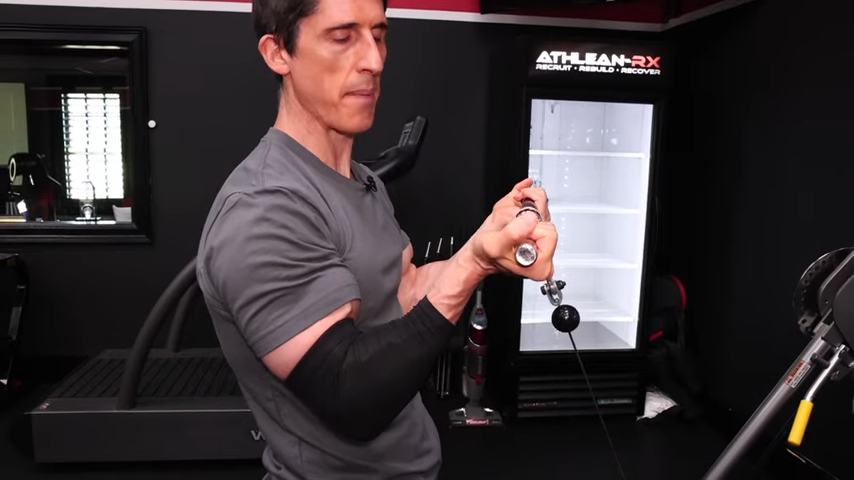
HOW TO DO THE DUMBBELL OFFSET STANDING CURL:
- Grab a pair of dumbbells and stand tall with your chest up, shoulders back, and elbows close to your sides.
- Instead of gripping the dumbbell evenly, slide your hand toward the thumb side of the handle so there’s more weight toward your pinky.
- Begin with your palms facing in (neutral grip).
- As you curl the dumbbell upward, rotate your wrist so that your pinky turns toward your shoulder. This is the active supination that I mentioned above.
- Squeeze hard at the top for one to two seconds, then slowly lower the dumbbell back down, controlling the eccentric phase.
- Be sure to keep your elbow fixed at your side throughout. Don’t let it drift forward. That keeps tension where you want it: on the short head of the biceps.
WHAT MAKES IT EFFECTIVE: This small tweak changes everything. By offsetting your grip, the dumbbell naturally wants to roll your forearm into pronation (palm facing down). To keep it controlled, your biceps have to fight back by actively supinating and that’s one of their key functions. This drives greater muscle activation in the short head of the biceps.
SPIDER CURLS

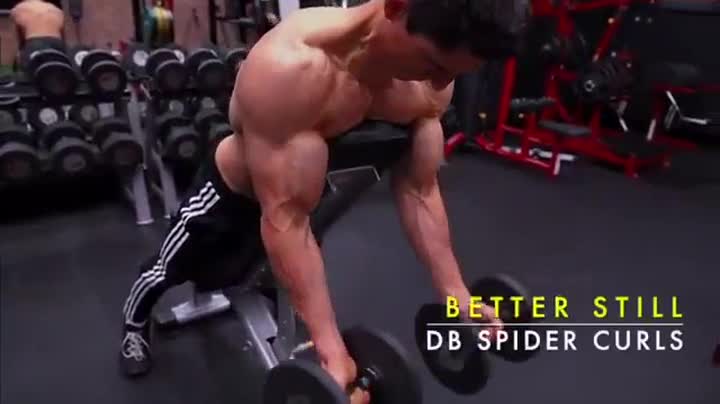
HOW TO DO THE SPIDER CURL:
- Start by setting an adjustable bench to about a 45-degree incline.
- Grab a pair of dumbbells and lie face down on the bench so your chest is supported and your arms can hang freely toward the floor.
- Keep your palms facing forward for the standard version, or turn them inward for a Hammer Curl variation.
- From this position, curl the dumbbells up by flexing at the elbows, not the shoulders. Keep your upper arms perpendicular to the floor and avoid swinging or shifting your body.
- At the top, squeeze your biceps hard for a second or two, then lower the weight slowly for three to four seconds to maximize time under tension.
WHAT MAKES IT EFFECTIVE: The Spider Curl hits your biceps in one of their most underrated positions: elbows in front of the body. That forward angle locks your shoulders in place and keeps constant tension on the short head of the biceps through the entire range of motion. Because your arms start in a fully extended position, you get deep muscle elongation at the bottom, followed by peak contraction at the top.
DUMBBELL PREACHER CURL

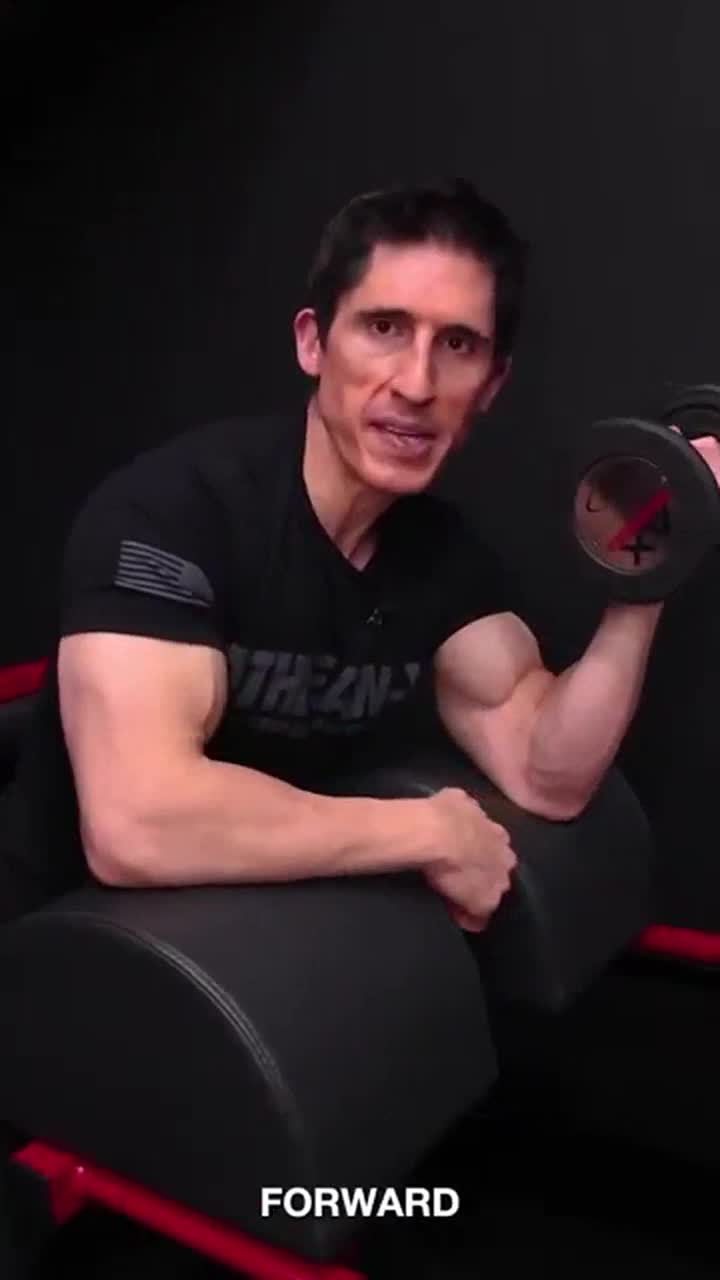
HOW TO DO THE DUMBBELL PREACHER CURL:
- Set your preacher bench so the pad supports your upper arm comfortably without forcing your shoulder into an awkward angle.
- Sit down with your feet shoulder-width apart and planted firmly on the floor.
- Position your upper arm flat against the pad and hold a dumbbell with a supinated grip (palm facing up).
- Start with your arm almost straight, keeping just a slight bend at the elbow to protect the joint.
- From here, curl the dumbbell upward by flexing your bicep. Keep the elbow pinned against the pad the entire time.
- At the top, squeeze your bicep hard for a one-second hold, then lower the weight slowly under full control.
- If you’re new to this, start light. The goal is control, not ego lifting. Every rep should feel locked in and deliberate.
WHAT MAKES IT EFFECTIVE: The Dumbbell Preacher Curl is one of the most effective ways to isolate the short head of the biceps because it locks the elbow in front of the body, which is the position where the inner bicep works hardest. The pad eliminates momentum and shoulder involvement, meaning the biceps brachii do all the work.
SEATED DB CURL PLUS

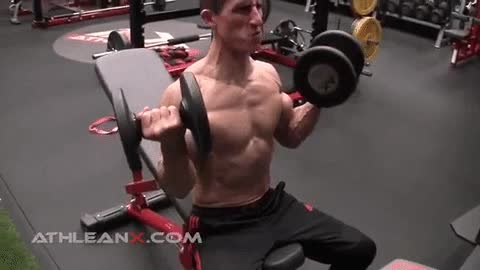
HOW TO DO THE SEATED DUMBBELL CURL PLUS:
- Sit tall on the edge of a flat bench with a pair of dumbbells resting on your thighs. The dumbbells are not hanging straight down at your sides like a traditional curl.
- This starting position is key. It sets your arms slightly in front of your body, shifting tension onto the biceps instead of the brachialis or brachioradialis.
- From here, curl the dumbbells upward under full control. Keep your elbows locked at your sides and your palms turning upward into a supinated grip as you lift.
- At the top, drive your elbows slightly forward and add a small lift of the shoulders. This subtle shoulder flexion increases tension on the short head of the biceps.
- Squeeze hard at the top for one to two seconds, then lower the dumbbells slowly back to your thighs, controlling the negative all the way down. Avoid bouncing off your legs or using momentum.
WHAT MAKES IT EFFECTIVE: The Seated Dumbbell Curl Plus eliminates the biggest sources of cheating: swing and inertia. By starting from your thighs instead of your sides, you remove the assistance of the brachialis and brachioradialis, forcing the biceps brachii, especially the short head, to handle more of the load.
NO MONEY CURL

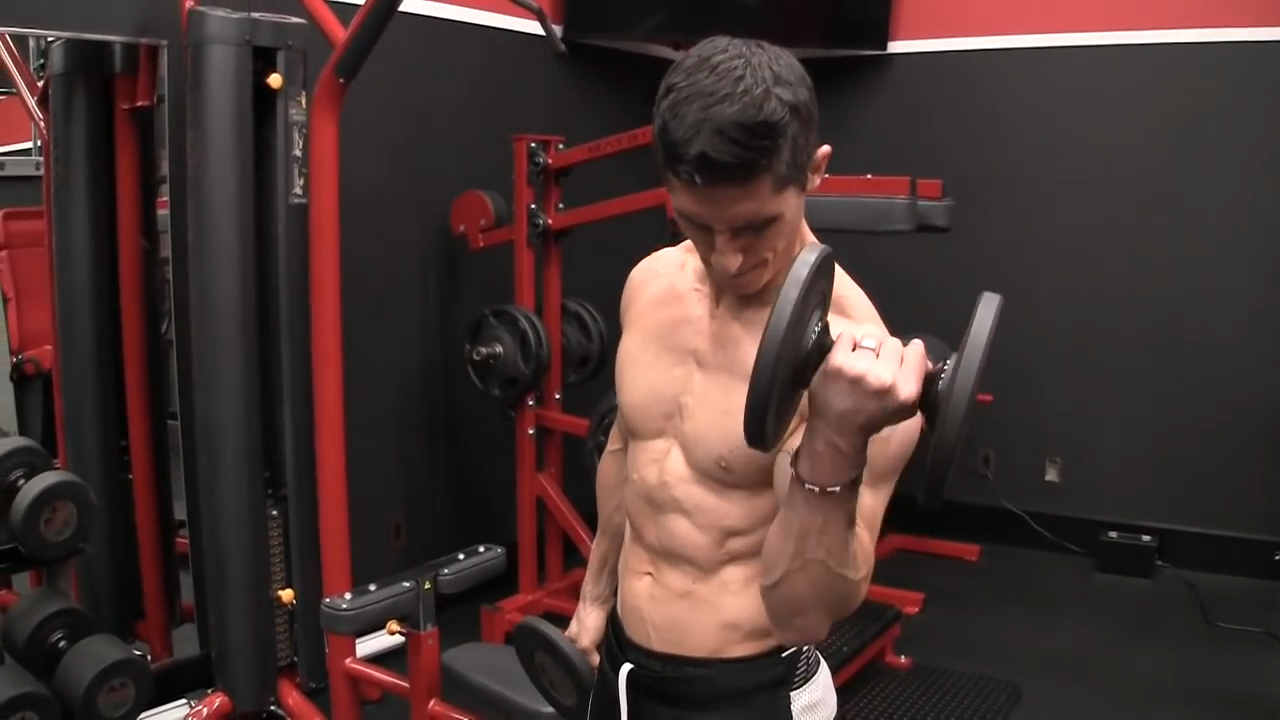
HOW TO DO NO MONEY CURLS:
- Stand tall with your feet hip-width apart and a dumbbell in each hand. Keep your chest up, shoulders back, and core tight.
- Start with your elbows bent to 90 degrees and your palms facing each other in front of your body.
- As you curl the weights slightly upward, begin to rotate your wrists outward, so your palms turn away from your midline like you’re saying, “I’ve got nothing in my hands.”
- Keep your elbows tucked close to your sides and focus on that external rotation through the shoulders as you squeeze your biceps.
- Lower slowly back to the start, maintaining full control and tension the entire way.
WHAT MAKES IT EFFECTIVE: Most curls focus only on elbow flexion, but the No Money Curl adds a critical second component: external rotation. This small rotation recruits more fibers in the short head of the biceps, forcing it to work harder to stabilize and contract. By keeping the elbows fixed and rotating the wrists outward, you isolate the inner portion of the biceps that gives your arms that wide, full look from the front.
HIGH CABLE BICEP CURL

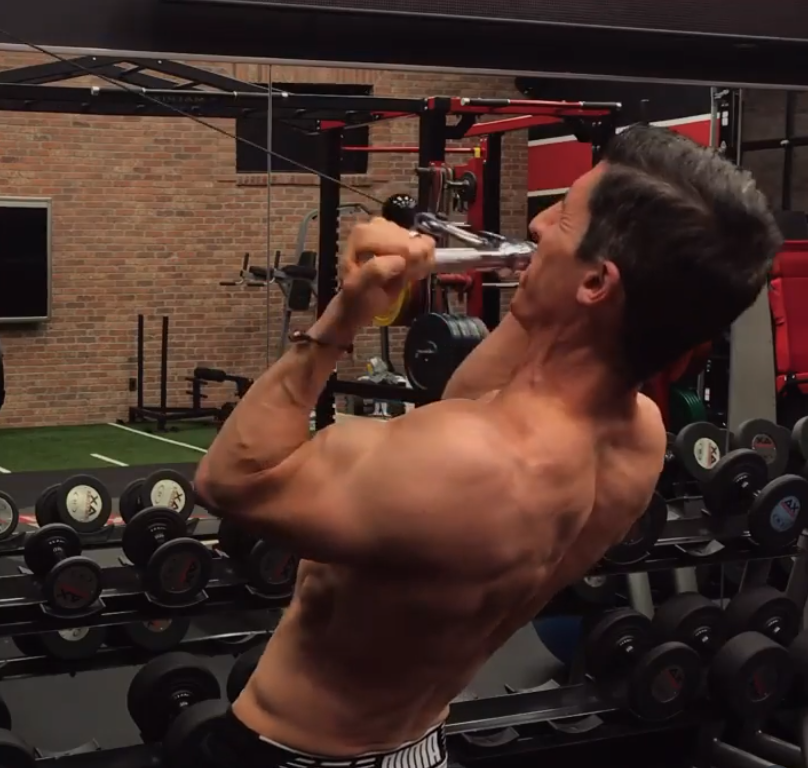
HOW TO DO HIGH CABLE BICEP CURLS:
- Set a straight or EZ bar attachment on the upper pulleys of a cable crossover station, just above shoulder height.
- Step back a few feet until there’s light tension in the cables and grab the bar with a supinated grip (palms up).
- Start with your elbows high and slightly in front of your shoulders. This is the position that locks tension onto the short head of the biceps.
- From here, curl the bar toward your face, focusing on bringing it just below chin or eye level. Squeeze hard at the top.
- Next, lower the bar down to your thighs like the eccentric portion of a traditional curl.
- From that low position, curl it back up toward your face again, then extend it back out toward the cable stack to return to your starting point.
- You’ll notice a slight lean back helps keep your balance and maintain a consistent resistance angle throughout the movement. Keep your core tight and your feet grounded to stay stable.
WHAT MAKES IT EFFECTIVE: This version of High Cable Curls turns a simple isolation move into a full-range short head challenge. By combining the high-position curl (for peak contraction) with the thigh-level curl (for full stretch and elbow flexion), you’re overloading the biceps through multiple parts of the strength curve in one continuous motion.
CONCENTRATION CURLS


HOW TO DO CONCENTRATION CURLS:
- Sit on the edge of a flat bench with your feet flat and knees apart. Hold a dumbbell in one hand using a supinated grip (palm facing up).
- Lean slightly forward and wedge your working arm against the inside of your thigh, close to the groin.
- From here, curl the dumbbell toward the outside of your shoulder, not straight up. This slight outward path lines up perfectly with the short head of the biceps.
- Keep your upper arm locked in place the entire time.
- At the top, squeeze hard and rotate your pinky toward your shoulder for a full supination and peak contraction.
- Lower the weight slowly and under control, letting your arm extend fully without losing tension.
WHAT MAKES IT EFFECTIVE: By locking your elbow against your thigh, you eliminate help from the front delts and momentum, forcing the biceps to do all the work. That forward-leaning position and slight outward curl path create complete elbow flexion and supination, lighting up the short head from the first rep to the last.
SHORT HEAD BICEP EXERCISES: COMMON MISTAKES
If you’ve been training arms for years but still aren’t seeing that full, round look from the front, chances are you’re making a few key mistakes that kill short head activation.
Proper muscle anatomy awareness, full range of motion, and controlled progressive overload make the difference between average curls and noticeable growth.
Here’s what’s holding most lifters back and how to fix it.
USING A NARROW GRIP ON EVERY CURL
If your hands are too close together on every curl, you’re biasing the long head and neglecting the short head.
A narrow grip keeps your elbows tight to your sides, which limits how much the inner biceps can contribute to elbow flexion.
Over time, this imbalance creates tall but narrow biceps with little front-view fullness.
Use a shoulder-width or slightly wider grip on your Barbell Curls or EZ Bar Curls.
This grip externally rotates your shoulders and naturally shifts tension inward to the short head of the biceps.
Feel your elbows drive slightly forward as you curl. This alignment places the short head in its strongest anatomical position and builds that dense, round look.
FLARING THE ELBOWS FORWARD TOO EARLY
This is one of the fastest ways to turn a bicep curl into a front-delt exercise.
When your elbows drift forward early in the movement, the shoulder starts handling the load and tension breaks down in the biceps.
You lose isolation, stability, and effective muscle engagement.
Keep your elbows glued to your sides until you’re halfway through the lift. Only at the very top should they move slightly forward into shoulder flexion, which naturally recruits the short head.
Exercises like the Incline Curl or Resistance Band Curl help reinforce this control. Both force you to maintain tension without letting the shoulders dominate.
Treat your elbows like anchors. If they move, you lose.
SWINGING THE WEIGHT
Momentum might move the dumbbell, but it doesn’t build muscle. When you swing the weight, you’re letting gravity do the work instead of your biceps.
The eccentric phase (the part of the lift that drives muscle hypertrophy) gets completely skipped.
Want to fix it? Slow down.
On every rep, take a few seconds on the way down. This increases time under tension and creates the microtears that stimulate growth.
Keep your torso still and control the dumbbell through the entire strength curve.
SKIPPING WRIST ROTATION
The biceps’ main function isn’t just curling. It’s also supinating the forearm. If you’re not rotating your wrist during the curl, you’re ignoring half the muscle’s job.
That means you’re missing out on short head activation.
Start each rep with a neutral grip (palms facing each other), then rotate your pinky toward your shoulder at the top.
This simple rotation, called elbow supination, fully engages the short head and gives you a stronger contraction.
STOPPING SHORT OF FULL RANGE
Partial reps might make you feel strong, but they rob your biceps of tension where it counts most: at full stretch.
Without reaching that point of muscle elongation, you’re only training the top half of the curve and missing critical fiber recruitment at the bottom.
Lower the weight until your arms are fully extended but not locked out. Feel that deep stretch through the biceps before curling back up.
This ensures you’re working through the muscle’s complete range of motion, which is key for balanced growth and durability.
IGNORING TENSION AT THE TOP
Too many lifters hit the top of a curl and just rest there. That’s like crossing the finish line and taking a nap.
The top of the curl is where peak contraction and maximum tension occur, especially for the short head. If you skip this, you’re skipping the most productive part of the rep.
Squeeze and hold the contraction for one to two seconds at the top of each rep, especially on resistance band or cable curls where tension stays constant.
Focus on trying to “crush” the dumbbell in your hand as your pinky rotates inward. This builds isometric strength and teaches your biceps to generate tension where most lifters lose it.
PROGRAMMING AND PROGRESSION
You can’t just sprinkle these movements into your routine and expect your arms to blow up.
Training the short head isn’t about random exercise selection. It’s about smart programming.
If you want to grow new muscle and not just burn through a few sets of curls, you need to treat your arm training like any other muscle group: with purpose, precision, and progression.
PLACEMENT IN YOUR WORKOUT
Think of short head training as the refinement phase of your arm development.
The big, compound pulling exercises are the foundation. They build overall arm strength and thickness, but they don’t isolate the short head of the biceps effectively on their own.
That’s where your targeted short head work comes in. Here’s where you should put short head bicep exercises in your routine.
If you’re running a push/pull split, the best time to train the short head is after your heavy pulling movements.
Think of it as a focused burnout that isolates the biceps after they’ve already been pre-fatigued by compound lifts.
For example, if your pull workout starts with Weighted Pull-Ups, Barbell Rows, and Lat Pulldowns, transition into short head–focused work like Spider Curls, High Cable Curls, or Offset Dumbbell Curls to finish.
Your biceps are already warm and partially taxed, which means you’ll need less weight to reach full activation, reducing joint stress and improving control.
When you dedicate a full session to arms, your strategy shifts. This is your chance to go all in on biceps and triceps.
Here, you’ll start your workout with heavier, compound curl variations that allow you to overload the muscle safely, followed by your short head isolation work.
Begin with a big movement like Barbell Curls, EZ Bar Curls, or Seated Dumbbell Curls to load the muscle through the midrange.
After that, transition into your short head–dominant lifts like Preacher Curls, Spider Curls, Cable Curls, or No Money Curls.
This sequencing lets you take advantage of fresh strength early, then target the short head under full fatigue for maximum recruitment.
SETS AND REPS
The short head responds best to moderate weight and high-quality contractions. You want control, not chaos.
Here’s how to structure your sets:
Hypertrophy (Muscle Growth): Perform 3 to 4 sets of 8 to 12 reps. Keep rest between 60 to 90 seconds, and focus on time under tension, especially on the way down.
Strength: I recommend doing 4 to 5 sets of 5 to 8 reps. Go heavier, rest around 2 minutes, and maintain perfect form.
Definition/Endurance: You should perform 2 to 3 sets of 12 to 15 reps. Use a lighter load, move slower, and emphasize the squeeze at the top.
If you’re doing it right, your biceps should burn long before your grip gives out.
WEEKLY TRAINING FREQUENCY
You don’t need to train arms every day to grow them. You just need to train them right.
Two direct bicep sessions per week is the sweet spot for most lifters.
That’s enough training frequency to create a consistent growth signal without interfering with recovery.
If you’re hitting a push/pull split, spread your arm work across both sessions. For example, one day emphasizing the short head, and the next focusing more on the long head or brachialis.
Always give yourself at least 48 hours between bicep-focused sessions to allow for full recovery.
HOW TO KEEP GROWING
When it comes to building the short head of the biceps, progressive overload isn’t just about throwing more weight on the bar.
In fact, adding load too early is one of the fastest ways to kill tension and wreck your form. The goal isn’t to move the weight faster. It’s to make the muscle work harder with every inch of movement.
Before even thinking about increasing the load, master the mechanics.
Focus on supination or that twist of the wrist that turns your pinky toward your shoulder because that’s what truly engages the short head.
Next, add time under tension by slowing down the eccentric phase (the lowering portion of the curl) or holding the squeeze for one or two seconds at the top. Those small adjustments dramatically increase the quality of your reps without changing the weight.
You can also incorporate mechanical drop sets to push past fatigue safely.
Start with a wide grip, which biases the short head, then gradually move to neutral or narrow as you tire.
Finally, alternate between seated and standing curls throughout your training cycles. This variation challenges your stabilizers, prevents overuse injuries, and forces the muscle to adapt in different positions.
Training the short head of the biceps is about mastering leverage, especially how elbow position, grip, and rotation shift tension where it counts.
The right movements transform an ordinary curl into targeted work that builds the inner thickness and round contour of the biceps that typical routines fail to develop.
With consistent programming and controlled execution, the short head becomes a major driver of balanced, noticeable arm development.
Check out our complete line of ATHLEAN-RX Supplements and find the best training program for you based on your fitness level and goals.

- Training the short head of the biceps gives your arms real width and front-view fullness. It rounds out your physique instead of just building a tall peak.
- Strengthening it also improves overall arm balance and joint stability, allowing you to generate more control and force through every curl and pull movement.
- Here are my picks for the best short head bicep exercises:
- Dumbbell Offset Standing Curl: Offsetting your grip shifts the resistance toward supination, forcing the short head to work harder through both curl and rotation.
- Spider Curls: With the elbows positioned in front of the body, this exercise keeps constant tension on the short head from full stretch to peak contraction.
- Dumbbell Preacher Curl: The preacher pad locks your elbow in front of your torso, isolating the short head and eliminating shoulder assistance.
- Seated DB Curl Plus: Starting from the thighs and finishing with a forward elbow drive adds shoulder flexion, which directly overloads the short head.
- No Money Curl: The external shoulder rotation combined with slight elbow flexion fires up the inner biceps, hitting the short head through its stabilizing role.
- High Cable Bicep Curl: Keeping the elbows elevated throughout creates continuous tension in the short head, especially at the top of the range.
- Concentration Curls: The fixed elbow position and full supination isolate the short head completely, maximizing contraction with minimal momentum.
SHORT HEAD BICEP EXERCISES FAQ
If you want to build the inner portion of your biceps, the part that gives your arms width and front-view fullness, you need exercises that keep your elbows in front of your body and involve supination (rotating the wrist so your palm faces up).
These two mechanics are what fire up the short head of the biceps.
Some of the best options include the Dumbbell Offset Standing Curl, Spider Curls, and the Dumbbell Preacher Curl.
Each one forces you to fight gravity in the right direction (toward the front of your body) and that keeps tension on the short head throughout the movement.
If you prefer cables, the High Cable Bicep Curl locks your elbows high and creates constant tension across the strength curve.
Finally, the No Money Curl or Concentration Curl help you focus purely on form and contraction.
The key is keeping the elbows forward, the wrists rotating outward (supination), and the movement controlled. That’s how you make the short head do its job.
The short head of the biceps sits on the inner portion of your upper arm, while the long head runs along the outer portion and creates that tall, narrow “peak.”
To target one over the other, it all comes down to arm position and shoulder angle.
If your elbows are in front of your torso (like in Spider Curls, Dumbbell Preacher Curls, or High Cable Bicep Curls), you’re biasing the short head.
This position combines elbow flexion with a degree of shoulder flexion, which shifts tension toward the inner bicep.
The Dumbbell Offset Standing Curl and Seated DB Curl Plus add another layer of overload by incorporating supination and that slight elbow drive forward at the top.
In contrast, to hit the long head, your elbows need to move behind your torso and engage positions that stretch the biceps more and favor the outer head.
For example, I’d recommend exercises like Incline Curls and Drag Curls, if you’re targeting the long head of the biceps muscle.
Put in a simpler way:
- Elbows forward = Short head (width, roundness, inner bicep)
- Elbows behind = Long head (height, peak, outer bicep)
Use that as your guide. Train both over the week, but if you’re chasing that full, powerful arm from the front, spend more time in the short head zone.
REFERENCES
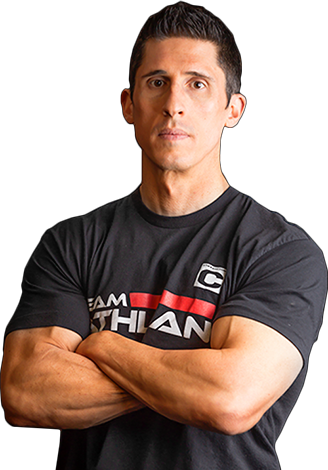
Jeff Cavaliere M.S.P.T, CSCS
Jeff Cavaliere is a Physical Therapist, Strength Coach and creator of the ATHLEAN-X Training Programs and ATHLEAN-Rx Supplements. He has a Masters in Physical Therapy (MSPT) and has worked as Head Physical Therapist for the New York Mets, as well as training many elite professional athletes in Major League Baseball, NFL, MMA and professional wrestling. His programs produce “next level” achievements in muscle size, strength and performance for professional athletes and anyone looking to build a muscular athletic physique.
